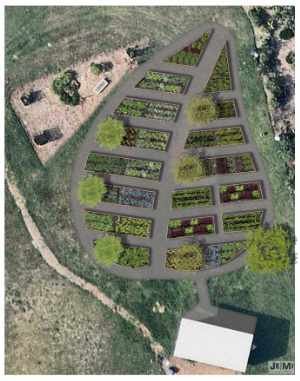Lennox community gardeners tell their story
This story first appeared in Garden Clubs of Australia magazine, Summer 2021/22 edition…
Meet our community gardeners
Q&A with Lennox Community Gardens
Story and photos by Lennox Community Gardens, November 2021
What’s the name of your community garden and where is it?
Our community garden is called Lennox Community Gardens. It’s based in Lennox Herad, in the Northern Rivers region of NSW. the reason we used the word Gardens (plural) is because, when our group first formed, it was difficult to find a single site that was large enough. Our thoughts at the time were to have several small community allotments scattered throughout the town. However, after four years of community consultation, council granted us a licence over around 3,000 square metres of grassland within a relatively unused public reserve known as Ocean Breeze Reserve.

How long has your community garden been established?
Our group was incorporated in July 2015 but planting did not begin until April 2019. We have now been operating for more than two years and are beginning to enjoy our first fruit!
What inspired its beginning?
There wasn’t one defining moment. Our founding team had varying motivations, including a design to act locally to reduce the effects of climate change, to develop a sense of community spirit and to get active and outdoors. There is a great dynamic within our team and some fantastic synergies with the skills and passions of our members.
How many people are involved?
We just signed up our 45th member, which sets a new milestone. Memberships cost $25, which is effectively a donation as the garden is completely open and accessible to members of the public at all times. there are no fences and everyone, without exception, is welcome to pop in and pick something to eat.

What sort of plants are grown in the garden? Any real favourites?
Our Vice President and chief garden designer Grant is a real enthusiast when it come to rare tropical fruit. He has sources wood stock from around the world and used it to graft some really interesting varieties including:
- Native Australian longan, which many Australian would now have heard of
- Pouteria butyracarpa, which is almost extinct in its native environment in the Amazon
- Orange sherbet mango, which tastes like an orange flavour Push Pop!
- ‘Erdon Lee’ lychee, which grows fruit the size of tennis balls!
We are also attempting a purpler mangosteen, which has the local Thai community excited. It’s a bit far south climatically so growing it is a bit experimental.
Finally, we are growing five varieties of banana, including red and blur bananas, with more varieties on their way, including plantains.
The idea is to introduce people to flavours and sensations that are not available at their local supermarket, to give them a new experience and hopefully inspire them to get involved or grow their new favourite foods in their own backyards.

What happens to the produce?
This is a pertinent question to us now that the garden is reaching maturity. A lot of the produce is harvested during our twice-weekly working bee yes and divvied up amongst members. Any excess is left out for anyone to take. However we are in the process of constructing what we affectionately call the ‘Leaf garden’.

This is a series of raised garden beds in the shape of a leaf which will dramatically increase our capacity to grow annual crops. As such, we are looking for avenues to donate or sell these. One example is a deal we recently struck with our local bowling club to purchase and promote our crops on their menu as local and organic. In return, the gardens will receive an income and food scraps, which we will compost and return to the soil to produce more crops and so on. It’s a truly closed loop process with virtually no food miles.
Who is the keenest gardener?
Credit for the keenest gardener and hardest worker must go to Dianne who is one of our committee members. Raised in Scotland, Dianne is an absolute workhorse. Of course, thanks must go to all of our members who attend our working bees, and also our neighbours who roll their sleeves up and help out from time to time.
Any special points about your garden that your’s like to share?
This year saw the establishment of our ‘kids committee’ which was an exciting moment for our younger members. It’s a great way to engage with them, and to foster our next generation of leaders. The children have their own dedicated [lots and make decisions about how they are used. It is a great platform for them to develop a range of skills, especially communication and diplomacy.

